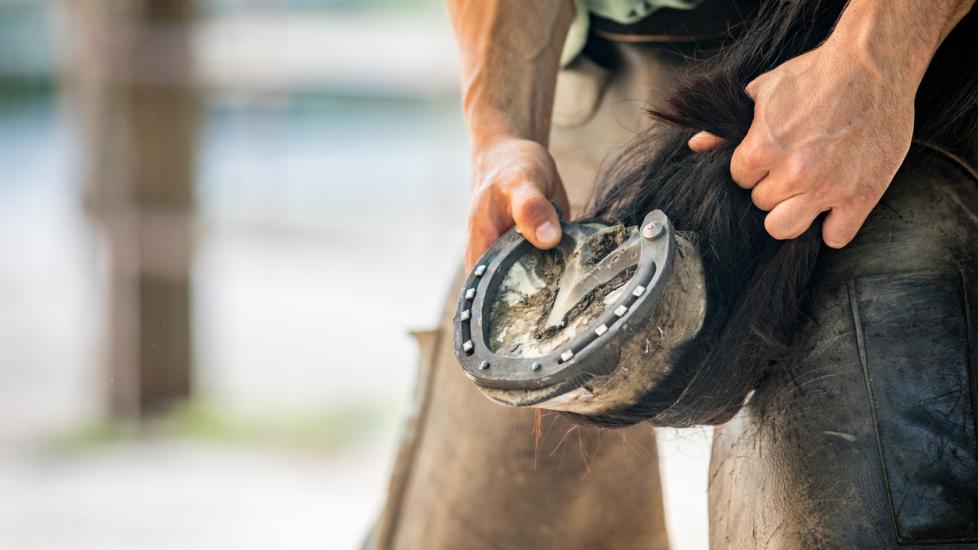Shoes for Horses: Everything You Need to Know
The decision to shoe your horse can be very intimidating, but don’t worry, it doesn’t have to be. In fact, some horses do not need shoes at all! Keeping horses barefoot can improve your horse’s overall hoof and musculoskeletal health.
However, with the domestication of horses and the requests we make of them, we have created challenges to keeping a horse barefoot. The decision to put shoes on your horse should be determined by your horse’s individual circumstances, including their genetics, management, and routine.
Why Do Horses Have Horseshoes?
Horseshoes have been used since our early ancestors domesticated horses. For working horses, the horseshoe was developed to prevent wear and tear of the hoof capsule. The hoof is a very dynamic structure, but without a protective shoe, the wear and tear on the hoof capsule may exceed its ability to compensate.
Throughout history there have been many different types of horseshoes made from different materials. Today, most horseshoes are made from aluminum and steel.
Horseshoes are also used in many equestrian sport disciplines. Eventing and jumping horses may wear shoes that help the structure of the equine foot to withstand the loads placed on it while performing. Racehorses may wear shoes to better grip the surface while running and to propel themselves forward. Horseshoes may also provide better traction for different surfaces, for example in snow or icy conditions.
Horseshoes are also used for therapeutic purposes. Special shoes may be required for horses suffering from the following conditions:
-
Collateral ligament strain
-
Hoof wall defects
-
Poor foot conformation
Working as a team with your veterinarian and farrier is necessary to manage and treat these conditions.
Do Horseshoes Hurt Horses?
Neither the application nor wearing of horseshoes should cause pain to your horse.
The equine hoof is comprised of an outer hoof capsule and the internal structures (the bones, tendons, ligaments, and blood vessels).
The outer hoof capsule is attached to the internal structure by the lamella, a sensitive soft tissue structure. The outer hoof capsule is made of keratin, the same material that makes up our fingernails and hair.
The nails that attach a horseshoe to the hoof are placed into the outer hoof wall, which has no feeling. If a nail is placed in the wrong place however, it will be painful and may lead to lameness or infection, like a hoof abscess.
Pros and Cons of Horseshoeing
Pros:
-
Support of hoof and internal structures
-
Protection of hoof wall
-
Treatment of medical conditions
-
Enhancement of performance in equestrian disciplines
Cons:
-
Weakening of the natural hoof
-
Risk of shoe application mistakes
-
Cost
-
Losing a shoe
-
Changes or impairment to natural foot balance
Horse Hoof Maintenance
The hoof wall continuously grows from the coronet band, so it needs to be worn down or trimmed routinely.
During the summer, horse hooves should be trimmed or re-shod every six to eight weeks. Some sport horses may need more frequent shoeing.
In the winter, horses’ hooves grow slower, so may only need to be trimmed every six to 12 weeks. Each horse will vary slightly, and it is best to work with your farrier to maintain the appropriate schedule.
Additional support for your horse’s hooves may include a hoof supplement that contains biotin, like Cosequin® ASU Joint and Hoof Supplement, in some cases applying a hoof hardener, like Keratex® Hoof Hardener.
Horseshoeing Alternatives
Glue-on Shoes
There are a few alternatives to traditional nail-on shoes. Glue-on shoes were developed for use in horses with sensitivity to nails and for horses with hoof wall defects where a nail cannot be placed. Glue-on shoes use an adhesive to attach an aluminum shoe to the hoof.
Wooden Shoes
Wooden shoes are often used as therapeutic shoe. After the hoof is trimmed appropriately, the wooden shoe is glued onto the bottom of the foot. It helps stabilize the hoof capsule while promoting hoof wall growth from the coronet and increasing sole depth.
Hoof Boots
A less permanent foot protection, boots or outer coverings for the hoof can be taken on or off as needed. The EasyCare® Easyboot Zip Horse Boot can be used to medicate or soak a hoof for medical treatment or allow a period of turnout for a horse with a medical foot problem that you want to keep from being exposed to the environment.
Other hoof boots, like the EasyCare® Easyboot Trail, can be used for trail riding or even to wear during turnout time. Many endurance trail riders find hoof boots helpful.
Featured Image: iStock.com/CasarsaGuru
References
-
Boyce, M. University of Minnesota Extension. Caring for your horse’s hooves. 2021.
-
O’Grady, S. American Association of Equine Practitioners. Proper Physiological Horseshoeing: What is it? How Do We Apply It? 2009.
-
O’Grady, S. American Association of Equine Practitioners. How to Evaluate the Equine Hoof Capsule. 2013.
-
Poupard, D. American Association of Equine Practitioners. Glue-On Technology and an Innovative New Technique. 2010.
